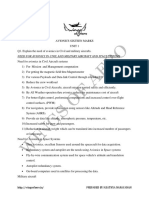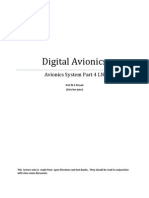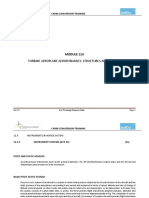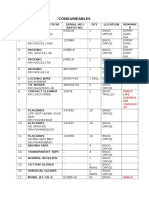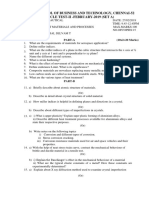0 ratings0% found this document useful (0 votes)
124 viewsModule Syllabus
This document outlines the syllabus for several sub-modules related to aircraft maintenance as per CAR 66, including electronic instrument systems, basic computer structure, electrostatic sensitive devices, aircraft instrument systems, avionics systems, electric systems, lights, integrated modular avionics, cabin systems, and information systems. For each sub-module, it lists the typical systems and components covered as well as the relevant ATA reference codes.
Uploaded by
Kuldeep SinghCopyright
© © All Rights Reserved
Available Formats
Download as DOCX, PDF, TXT or read online on Scribd
0 ratings0% found this document useful (0 votes)
124 viewsModule Syllabus
This document outlines the syllabus for several sub-modules related to aircraft maintenance as per CAR 66, including electronic instrument systems, basic computer structure, electrostatic sensitive devices, aircraft instrument systems, avionics systems, electric systems, lights, integrated modular avionics, cabin systems, and information systems. For each sub-module, it lists the typical systems and components covered as well as the relevant ATA reference codes.
Uploaded by
Kuldeep SinghCopyright
© © All Rights Reserved
Available Formats
Download as DOCX, PDF, TXT or read online on Scribd
You are on page 1/ 3
S.
Sub-Modules Syllabus as per CAR 66
No.
1. 5.1 (Electronic Typical systems arrangements and cockpit
Instrument layout of electronic Instrument systems.
Systems)
2. 5.6 (Basic (a) Computer terminology (including bit, byte,
Computer software, hardware, CPU, IC, and various memory
Structure) devices such as RAM, ROM, PROM); Computer
terminology applied in aircraft.
3. 5.12 (Electro Special handling of components sensitive to
sensitive Devices) electrostatic discharges;
Awareness of risks and possible damage,
component and personal anti-static protection
devices.
4. 11.5.1 (Instrume Pitot static: Altimeter, Air-speed indicator,
nt System ATA Vertical Speed Indicator;
31) Gyroscopic: artificial horizon, attitude director,
direction indicator, horizontal situation indicator,
turn and slip indicator, turn coordinator;
Compasses: direct reading, remote reading;
Angle of attack indication, stall warning
systems;
Other aircraft system indication.
5. 11.5.2 (Avionics Fundamentals of system layouts and operation
Systems ATA 22, of:
23 & 34) Auto Flight (ATA 22);
Communications (ATA 23);
Navigation Systems (ATA 34).
6. 11.6 (Electric Batteries Installation and Operation;
Systems ATA 24) DC power generation;
AC power generation;
Emergency power generation;
Voltage regulation;
Power distribution;
Inverters, transformers, rectifiers;
Circuit protection;
External / Ground Power;
7. 11.14 (Lights External: Navigation, Anticollision, Landing,
ATA 33) Taxiing, etc.;
Internal: Cabin, Cockpit, Cargo;
Emergency
8. 11.19 (Integrated ATA-42 Functions that may be typically
Modular Avionics integrated in the Integrated Modular Avionic (IMA)
ATA 42) modules are, among others: Bleed Management, Air
Pressure Control, Air Ventilation and Control,
Avionics and Cockpit Ventilation Control,
Temperature Control, Air Traffic Communication,
Avionics Communication Router, Electrical Load
Management, Circuit Breaker Monitoring, Electrical
System BITE, Fuel Management, Braking Control,
Steering Control, Landing Gear Extension and
Retraction, Tyre Pressure Indication, Oleo Pressure
Indication, Brake Temperature Monitoring, etc.
9. 11.20 (Cabin ATA-44 The units and components which furnish a
Systems ATA 44) means of entertaining the passengers and providing
communication within the aircraft (Cabin
Intercommunication Data System) and between the
aircraft cabin and ground stations (Cabin Network
Service). Includes voice, data, music and video
transmissions.
The Cabin Intercommunication Data System
provides an interface between cockpit/cabin crew and
cabin systems. These systems support data exchange of
the different related LRU's and they are typically
operated via Flight Attendant Panels.
The Cabin Network Service typically consists on a
server, typically interfacing with, among others, the
following systems:
- Data/Radio Communication, In-Flight Entertainment
System.
The Cabin Network Service may host functions such
as:
- Access to pre-departure/departure reports,
- E-mail/intranet/Internet access,
- Passenger database;
Cabin Core System;
In-flight Entertainment System;
External Communication System;
Cabin Mass Memory System;
Cabin Monitoring System;
Miscellaneous Cabin System.
10. 11.21 (Information The units and components which furnish a means of
Systems ATA 46) storing, updating and retrieving digital information
traditionally provided on paper, microfilm or microfiche.
Includes units that are dedicated to the information
storage and retrieval function such as the electronic
library mass storage and controller. Does not include
units or components installed for other uses and shared
with other systems, such as flight deck printer or
general use display.
Typical examples include Air Traffic and Information
Management Systems and Network Server Systems
- Aircraft General Information System;
- Flight Deck Information System;
- Maintenance Information System;
Passenger Cabin Information System;
- Miscellaneous Information System.
You might also like
- Indicating / Recording: Operating ManualNo ratings yetIndicating / Recording: Operating Manual62 pages
- Encyclopedia of Physical Science and Technology - Aeronautics by Robert Allen Meyers PDFNo ratings yetEncyclopedia of Physical Science and Technology - Aeronautics by Robert Allen Meyers PDF227 pages
- Tech Notice 07 - Dual Cooling Tech Notice Final100% (2)Tech Notice 07 - Dual Cooling Tech Notice Final4 pages
- Module 11.5.2 - Fundamentals of System Lay-Outs and OperationNo ratings yetModule 11.5.2 - Fundamentals of System Lay-Outs and Operation10 pages
- AIRBUS A320/A330/A340 Electrical Flight Controls A Family of Fault-Tolerant SystemsNo ratings yetAIRBUS A320/A330/A340 Electrical Flight Controls A Family of Fault-Tolerant Systems8 pages
- AAE 3156 Avionics Subsystem Databus and Avionics Architecture100% (1)AAE 3156 Avionics Subsystem Databus and Avionics Architecture132 pages
- AAE 3282 Avionics Subsystem Databus and Avionics Architecture100% (1)AAE 3282 Avionics Subsystem Databus and Avionics Architecture128 pages
- Embedded Systems: Air Traffic Control SystemNo ratings yetEmbedded Systems: Air Traffic Control System18 pages
- A380-LEVEL III - ATA 46 Network Server System - Onboard Informati100% (11)A380-LEVEL III - ATA 46 Network Server System - Onboard Informati52 pages
- Unit 124 Aircraft Computers and Electronic SystemsNo ratings yetUnit 124 Aircraft Computers and Electronic Systems9 pages
- AIRBUS A320 A330 A340 Electrical Flight Controls - A Family of Fault-ToleranNo ratings yetAIRBUS A320 A330 A340 Electrical Flight Controls - A Family of Fault-Toleran8 pages
- Module 5: Digital Techniques and Electronic Instrument SystemsNo ratings yetModule 5: Digital Techniques and Electronic Instrument Systems81 pages
- A380 LEVEL III ATA 46 Network Server System Onboard Informati PDFNo ratings yetA380 LEVEL III ATA 46 Network Server System Onboard Informati PDF52 pages
- Need For Aionics, Requirement of Avionics SystemNo ratings yetNeed For Aionics, Requirement of Avionics System16 pages
- Avionics-Ae 2401: Unit - 1 Prepared by Rajarajeswari.M Mohammed Sathak Eng College0% (1)Avionics-Ae 2401: Unit - 1 Prepared by Rajarajeswari.M Mohammed Sathak Eng College129 pages
- Acp-Wgf24-Wp09 - Radio Altimeter Operation On Aircraft Rev1No ratings yetAcp-Wgf24-Wp09 - Radio Altimeter Operation On Aircraft Rev15 pages
- F3ab2814cedigital Avionics Part4 Avionics SystemsNo ratings yetF3ab2814cedigital Avionics Part4 Avionics Systems11 pages
- What Is Need of Defining Various Avionics Architecture?No ratings yetWhat Is Need of Defining Various Avionics Architecture?4 pages
- History: Avionics Is A Term Used To Describe All of TheNo ratings yetHistory: Avionics Is A Term Used To Describe All of The5 pages
- Airbus Fly-By-Wire: A Process Toward Total DependabilityNo ratings yetAirbus Fly-By-Wire: A Process Toward Total Dependability10 pages
- Common Avionics Architecture System CAASNo ratings yetCommon Avionics Architecture System CAAS10 pages
- Module 11.5.1 - Instrument Systems (ATA 31)No ratings yetModule 11.5.1 - Instrument Systems (ATA 31)31 pages
- Candidate Admitted List - Center Wise: Session: Session Type: March 2017 OnlineNo ratings yetCandidate Admitted List - Center Wise: Session: Session Type: March 2017 Online170 pages
- Module 11.6 - Electrical Power (ATA 24)No ratings yetModule 11.6 - Electrical Power (ATA 24)24 pages
- Consumeables: Shelf Life Expires ON 19/03/20 25No ratings yetConsumeables: Shelf Life Expires ON 19/03/20 253 pages
- First Aid Kit Content List: S. NO. Medicine Uses Expiry DateNo ratings yetFirst Aid Kit Content List: S. NO. Medicine Uses Expiry Date2 pages
- Powerful Robust Quiet: Local Power WorldwideNo ratings yetPowerful Robust Quiet: Local Power Worldwide4 pages
- Technical Brief: Flow Through A Repeating Stage in An Axial Compressor: A ReconsiderationNo ratings yetTechnical Brief: Flow Through A Repeating Stage in An Axial Compressor: A Reconsideration3 pages
- Model 252 Servovalves: Typical Applications OperationNo ratings yetModel 252 Servovalves: Typical Applications Operation2 pages
- 32 Shinden 2nd Edition Ah! My Goddess - Products - Zoukei-Mura Inc0% (1)32 Shinden 2nd Edition Ah! My Goddess - Products - Zoukei-Mura Inc8 pages
- Indian Navy - SSC Officers in Executive and Technical BranchesNo ratings yetIndian Navy - SSC Officers in Executive and Technical Branches1 page
- Type Acceptance Report: Turbo Commander 690 Series100% (1)Type Acceptance Report: Turbo Commander 690 Series10 pages













































